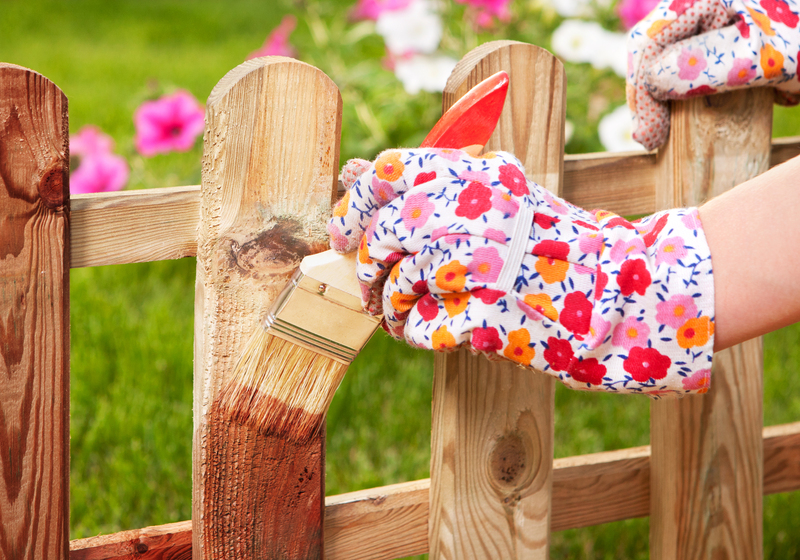Revamp Your Overgrown Garden: Where to Begin
Posted on 22/08/2025
Revamp Your Overgrown Garden: Where to Begin
If your outdoor space has turned into an untamed jungle, don't worry--transforming an unruly, overgrown garden into a beautiful and manageable paradise is possible! Revamping an overgrown garden can be overwhelming, but with a clear strategy, you can gradually restore order, enhance curb appeal, and create a vibrant green retreat you'll love. Whether you're a novice or an experienced gardener, this comprehensive guide will help you start the process, step by step.

Understanding the Challenge: Why Gardens Become Overgrown
Gardens can quickly get out of hand for various reasons--busy schedules, physical limitations, newly purchased properties, or simply a lack of gardening know-how. Before you jump in, analyze why your garden became overgrown. Recognizing these underlying causes can help prevent the same problems in the future.
- Neglect due to work or life commitments
- Lack of a maintenance plan
- Absence of proper garden design
- Invasive plant species taking hold
- Poor soil health causing rampant weed growth
By understanding the root causes, your garden overhaul will be more effective and sustainable.
Step 1: Assess the Scale of the Project
Before grabbing your tools, take time to evaluate your overgrown garden. Walk around and make notes or take photos. Consider:
- What plants are worth saving? Identify mature shrubs, trees, or perennials with potential.
- Which areas are most unruly? The back corner or a tangle of brambles along the fence?
- Are there hidden paths, patios, or features under the growth?
- Look for invasive species or diseased plants that need attention.
- Assess existing boundaries: are fences or edges visible or buried?
By mapping out your findings, you'll have a clearer picture of where to focus your efforts first, making the garden restoration less overwhelming.
Step 2: Set Clear Goals for Your Garden Transformation
As you begin to revamp your overgrown outdoor space, decide what you want to achieve. Some guiding questions include:
- What will you use your garden for? (Relaxation, entertaining, kitchen garden, wildlife habitat?)
- Do you prefer a low-maintenance garden or lush borders with vibrant color?
- Are there any features you want to add: a seating area, pond, or vegetable patch?
- What's your budget and timeline?
_Clarify your priorities_ before you start clearing, so you don't waste effort reviving plants or structures you'll later remove.
Step 3: Gather the Right Tools and Supplies
To tackle an overgrown garden renovation, you'll need a well-equipped toolkit. Essential items include:
- Gloves: Sturdy gardening gloves will protect your hands from thorns, stings, and debris.
- Secateurs and Loppers: For trimming smaller branches and overgrown shrubs.
- Pruning Saw: To deal with thicker branches or trees.
- Shears or Hedge Trimmers: For taming hedges and large perennials.
- Spade, Fork, and Hoe: Vital for digging, turning soil, and weeding.
- Rake: Clears leaves, cuttings, and general debris.
- Wheelbarrow or Garden Waste Bags: For moving or disposing of waste.
- String and Stakes: Mark out paths, beds, or supports for plants.
Depending on the extent of the work, you may also hire or borrow a strimmer or brush cutter for extensive areas of tall grass and weeds.
Step 4: Start with a Clean Slate - Clear the Debris
1. Remove Rubbish and Large Debris
Begin by collecting any litter, old furniture, broken pots, or other non-plant debris scattered through your overgrown backyard. This will immediately help you see what you're working with.
2. Cut Back Overgrown Grass and Weeds
Use a strimmer or shears to cut tall grass and weeds down to a manageable level. If grass is very thick, you may need several passes. Be careful as hidden stumps, rocks, or holes can be concealed beneath the growth.
3. Tackle Large, Invasive Plants First
Prioritize removing brambles, ivy, bamboo, or other invasive species. Dig roots out where possible to prevent regrowth. Tip: Dispose of invasive weeds safely--don't add them to your compost.
Step 5: Prune and Rescue Existing Plants
Your goal is garden restoration, not complete demolition. Mature shrubs and trees can often be revived with hard pruning:
- Remove dead or diseased wood first.
- Cut back overgrown branches to healthy growth points.
- Thin out dense shrubs to improve light and airflow.
- Perennials: Trim faded or dead foliage to reduce competition for water and light.
If you're unsure which plants are worth saving, wait a season to see what emerges after initial clearing.
Step 6: Define Boundaries and Garden Features
Now that you can see the ground, re-establish the layout of your garden:
- Reveal and repair existing pathways, patios, or decking. Use a spade or edging tool to clear the edges.
- Uncover and clean ponds, water features, or raised beds hiding beneath weeds.
- Re-trace borders and flower beds using string or stakes to mark clear lines.
- Assess fencing, gates, or trelliswork for repair or replacement.
Establishing structure is key to a successful garden makeover. These hard landscaping elements guide planting and organization as you revamp your neglected space.
Step 7: Plan Your Planting Scheme
Consider Your Soil and Microclimate
Test your soil (pH, texture, drainage) and observe sun/shade patterns. This informs what plants will thrive and which garden design best suits your site.
- Sandy, well-drained soils suit Mediterranean or drought-tolerant plants.
- Heavy clay retains moisture--great for lush borders or lawns but may need improvement.
- Partial or full shade? Choose shade-tolerant flowers and shrubs.
Design Your Layout
Sketch a plan--even a rough pencil outline helps. Think about:
- Create focal points (trees, sculptures, seating areas).
- Layer planting from tall at the back to low at the front of borders.
- Allow space for future growth and access for maintenance.
- Favor easy-care or native plants for a low-maintenance transformation.
Incorporate your saved plants and supplement with new selections for year-round interest.
Step 8: Improve Soil Quality
Reviving an overgrown garden often means restoring depleted soil. After weed and debris removal:
- Fork over compacted soil to relieve compaction and improve drainage.
- Add organic matter--compost, leaf mold, or well-rotted manure boosts fertility and structure.
- Mulch beds to suppress new weeds, retain moisture, and protect roots.
- If necessary, apply slow-release fertilizer to support new and existing plants.
Healthy soil is the foundation of a flourishing, low-maintenance garden.
Step 9: Replant, Refresh, and Reinvent
Once the groundwork is done, you can begin planting:
- Position new plants according to your plan and spacing guidelines.
- Group by light and water needs for efficient care.
- Add instant structure with mature specimens or feature pots where needed.
- Edge borders for a neat look.
- Lay new turf, sow grass seed, or install wildflower meadows for naturalistic charm.
Now's the time to be creative: try a pollinator-friendly mix, edible crops, or bold color schemes to make the space your own.
Step 10: Set Up a Simple Maintenance Routine
To prevent your rejuvenated garden turning wild again:
- Weed "little and often" for 10-15 minutes per week.
- Deadhead flowers and prune shrubs at the right times each year.
- Mulch and feed plants as required.
- Check boundaries, paths, and structures after storms or seasonally.
- Keep a garden notebook to track successes and issues.
*Consistency is more important than effort!* Even minimal regular care will keep your garden inviting and under control.
Expert Tips: Overhauling Overgrown Gardens Successfully
- Work in sections--don't try to do everything at once. Tackle one bed or area per weekend.
- Invite friends or family to help with heavy clearing or hire local professionals for big tasks.
- Wear protective clothing and check for hazards such as sharp objects, nests, or hidden cables.
- Compost green waste wherever possible to recycle nutrients back into your garden.
- Be patient: transformations take time! Allow several months or seasons for a full garden revival.
Common Mistakes to Avoid When Revamping an Overgrown Garden
- Impatience: Trying to rush the process can exhaust you and overlook important steps.
- Removing "good" plants: Give suspect plants a chance to regrow before discarding them.
- Ignoring soil health: Skipping soil improvement leads to poor long-term results.
- Overcomplicating planting schemes: Simple, resilient designs are easiest to manage.
When to Call in the Professionals
Large-scale garden clearance may require experts, especially if:
- There are unsafe trees, large stumps, or hazardous waste.
- You have very limited time, mobility, or experience.
- The garden is dense with invasive species or Japanese knotweed (needs regulated removal).
Professional landscapers can help with design and heavy tasks, while you handle ongoing maintenance and plantings.

Before and After: Inspire Your Transformation
_Imagine the satisfaction of walking through a vibrant, orderly garden instead of a bramble-filled wilderness._ By following these steps and establishing a sustainable maintenance routine, you can transform your overgrown backyard from chaos to calm, adding beauty, value, and outdoor enjoyment to your home.
Key Takeaways: Your Overgrown Garden Revival Checklist
- Assess the site and set achievable goals.
- Clear rubbish, debris, and aggressive weeds.
- Prune and rescue worthwhile plants.
- Define boundaries, pathways, and features.
- Improve soil and plan resilient plantings.
- Replant and add creative touches.
- Maintain your new garden with ease.
With the right approach, patience, and vision, your wild, overgrown garden can become a haven of beauty, wildlife, and relaxation.
Start Your Overgrown Garden Transformation Today!
Every stunning outdoor space begins with a single step. Whether your garden needs a full-scale revival or just a fresh start, you now have a clear guide on where to begin revamping your overgrown garden. Roll up your sleeves, gather your tools, and enjoy the process--soon you'll have a garden to be proud of!
```
